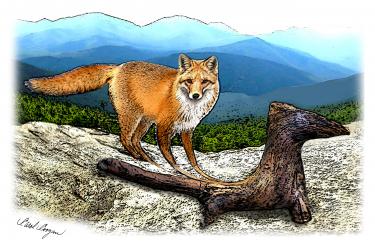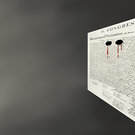From the editor: Twisted roots, quahog shells, rusted steel, and the tales they tell
I have been thinking a lot about objects lately.
My father’s house has just been sold. He had wanted to die there, and he did. It was the home that he and my mother built together.
It is filled with remnants of their passions. The books or recipes my mother used. The rugs, and blankets, and pillows she wove on her loom. My father’s workbench filled with the tools he used to hone the edges of his skis, to cut smooth turns as he taught telemark at Whiteface. The library of books he used during the course of a journalist’s career, and the books he read for pleasure with purpose — on poetry, philosophy, and politics. The stuff of lives well lived, each for 90 years or more.
There’s more. Much more. Heirloom furniture, passed down from earlier generations. The grape-sorting table that had been my grandmother's and served my parents as a cocktail table. We’d gather round at cocktail time to tell the stories of our days as we spun the table to pass the oeur d’oeuvres my mother made.
All of these objects were part of a whole. They outlived the people who had assembled them and so will be dispersed again. It’s a painful process my sisters and I are going through. We want to be fair, to be sure each gets her share to pass down to children — the next generation.
But, really, values cannot be assigned. The single object I most value would, in any objective sense, be considered worthless. It’s a piece of twisted root, maybe three inches long, weathered gray and brittle. My mother and I found it along a hiking trail the summer after my first year at college. It looked to us like a fox and became a sort of totem.
I had come home from that first year at Wellesley College as a feminist. I’d read Betty Friedan’s “The Feminine Mystique,” and Simone De Beauvoir’s “Le Deuxième Sexe,” and Virginia Woolf’s “A Room of One’s Own.” I had thought I would liberate my mother. She was such a bright and capable woman. Why did she devote herself entirely to being a wife and mother rather than pursuing a career of her own?
She knit our sweaters, braided our rugs, baked everything we ate from scratch, organized our family’s ski trips in the winter and hiking trips in the summer — in short, she was there to meet each of our needs, always.
As it turned out, she liberated me. That summer, as she nursed me back to health from debilitating mononucleosis, I remembered, too, how she had sustained me when, as a child, I had scarlet fever. Our house was quarantined in the era before antibiotics were readily available, and all my toys were burned. She let me wear her silken bed jacket and read to me hour after hour.
Once I was well that summer after my first year of college, my mother proposed we finish my 46 Adirondack High Peaks. In a book of memories put together for my 50th birthday, now 15 years behind me, my Mama wrote of that summer. We would conquer the wilderness together. “We ignored our doubts in starting a temperamental stove, of trusting our map-and-compass ability, of bear-proofing our food at campsites, of hefting packs heavy with food and gear for several days on the trail. We even ignored the black flies,” she wrote.
“We did laugh a lot and we did gain more confidence with each summit. We absolutely revelled when we met a father-son team who proudly said, ‘We’ve just climbed Skylight. Where have you hiked?’ We quietly boasted, ‘Oh, Cliff, Redfield, and Gray’ — and watched their surprised faces.”
She concluded, “We were a good team. That was a summer to always remember.”
I loved to follow my mother on the trail or bushwhacking through thick underbrush on trailless peaks. Her gait was steady. But she would stop to identify a new flower or lichen or listen to a bird call and know what kind it was. And so I treasure my little fox totem because it brings back the memories of that long-ago summer when I discovered as much about my mother and myself as I did about finding my way in the wilderness.
My fox, of course, would mean nothing to anyone else. It had sat all those years on my mother’s kitchen windowsill and my sisters were happy for me to have it.
Objects, though mute, can speak to later generations. In Altamont, when the late Marijo Dougherty was the village curator, she put together many exhibits of objects that spoke from the past to current residents.
One exhibit was about local inventors. The display included the paper patents as well as some of the actual objects invented. It made us think about the kind of can-do spirit of the late 1800s and early 1900s when villagers solved everyday problems by inventing solutions.
Earlier this year, I wrote about the Myers House in Albany’s ArborHill, which is being restored as tribute to abolitionists Harriet and Stephen Myers who once lived there. Stephen Myers was the editor of The Northern Star and Freeman’s Advocate. “We devote all our time to the care of the oppressed who come among us,” he wrote in 1860.
Mary Liz and Paul Stewart founded the Underground Railroad History Project in the 1990s, which purchased the house and — largely through grants and volunteer efforts — saved the venerable brick structure that had been on the verge of collapse.
Archeological digs in the neighborhood have unearthed thousands of pieces of the past, many of which are highlighted in displays at the Myers House. Mary Liz Stewart said items like an ornate vase are significant because there is a common misconception that African Americans before the Civil War were either slaves or very poor. The vase is a shining example, tangible proof, of the middle-class life that some African Americans in Albany led in the 19th Century.
And so objects can speak truths about a past that may have been slanted or rewritten over time.
This week, we received a notice from the New York State Museum that it has been given an 18th-Century Native American pipe tomahawk that President George Washington had given to the Seneca leader Gy-ant-waka in 1792. A pipe tomahawk was used for ceremonial smoking after an agreement was reached. Washington had met with Gy-ant-waka, whom the Europeans called Corn Planter, to develop the Treaty of Canandaigua, establishing peace between the newly formed United States and the Haudenosaunee Confederacy, known by Europeans as the Iroquois.
The treaty was signed by 50 war chiefs and sachems representing the Grand council of the Six Nations — the Cayuga, Mohawk, Oneida, Onondaga, Seneca, and Tuscarora tribes.
The hatchet was given to the state museum in 1850 by Ely S. Parker who had bought it from Small Berry, a member of the Seneca tribe. Parker replaced the shaft based on a description of the original from Small Berry’s wife. The blade of the hatchet says “Gy-ant-waka” on one side and “John Andrus,” perhaps the manufacturer, on the other.
Parker’s life story was told a century ago by his grand nephew, Arthur C. Parker, the state archaeologist of New York, in the book, “The Last Grand Sachem of the Iroquois or The Life and Times of Gen. Ely S. Parker. The younger Parker describes the elder as an engineer, lawyer, and tribal diplomat, serving as secretary to General Ulysses S. Grant during the Civil War. Ely S. Parker wrote the final draft of the surrender terms for the Confederacy, signed at Appomattox. As president, Grant appointed Ely S. Parker as the first Native American to be Commissioner of Indian Affairs.
The hatchet had been stolen from the state museum in the late 1940s and just this past June was returned by an anonymous collector. The hatchet will be displayed in the museum’s main lobby from July 17 to Dec. 30. I’m grateful to the collector who returned such a valuable object to the public and plan to go see it.
The pipe tomahawk is an object that raises many questions. It tells of a time when Europeans, forming a new nation on land long inhabited by others, feared the native inhabitants and attempted to work out a way to peacefully coexist.
Both the United States and the Haudenosaunee still recognize the treaty although in 1960 a large chunk of the Allegheny Reservation was taken by eminent domain to build the Kinzua Dam, displacing 600 Seneca.
But sadly, the native societies could not endure as they had on land so changed by the Europeans. Ely S. Parker was a man who could bridge both worlds and his gift to the people of New York in donating the pipe tomahawk was a telling one.
The very essence of the artifact — the blade a weapon that could harm and kill, and the pipe a means of shared smoking to sanctify an agreement — speaks of the difficulty of achieving peace.
How each of us interprets that may depend on who we are. Just as my mother and I read meaning into a root shaped like a fox, objects are open to interpretation based on experience.
In 1919, when Arthur C. Parker wrote the book on his great uncle, the New York State Museum also had “in a great steel vault” a wampum belt made of purple shell beads that “preserves in its mysterious strands the story of the rulers of a mighty American empire.”
Parker goes on, “Not every ‘reader of the wampum’ would tell the same story as he handled that sacred belt but each reader would undoubtedly tell his story with accuracy.”
In the 1980s, many of the wampum belts were returned to the tribes from whence they had come, and rightfully so since the belts serve as an archive for tribal history.
But Parker’s statement is telling, nevertheless. Even in the hands of tribal readers of the wampum, each reader tells his own story. The stories are different and yet each is accurate. How can that be so?
Perhaps objects are more than mere atoms; in human hands, they are imbued with projected meaning.
— Melissa Hale-Spencer



I enjoyed reading this article very much. I especially enjoyed your memories of your mother and how she liberated you.